Hair Hydration Inspired by Skin Care: Way Beyond Water Content!
Abstract
Dry hair requires restoration treatments to recover its hydration and healthy appearance. Hydration in hair is perceived by benefits other than water content. Hydroviton® Hair was then designed to meet the needs of this hair condition, with a film formation activity on the hair fibers that smooths them out, improving combability in wet and dry hair, increasing
the perception of softness and alignment, rebalancing electrostatic charges and thus being
also effective in controlling volume and frizz.
Introduction
Skin care and hair care are two different universes with different particularities, however, in the last twelve months the terms “care” and “skincare” have been widely seen on social media in hair care-related searches (
1).
This data reinforces the concept of “skinification”, where ingredients and claims used
mostly in skin care are entering the hair universe. A survey conducted by Symrise in 2019 with 50,000 volunteers from 20 countries investigated how consumers understand the hydration attribute.
Combability, softness, film formation, frizz and volume control, for example, are factors that add to the perception of hydrated hair, showing that the hair hydration claim implies benefits other than water retention. (
2)
Ingredients such as polyols (Sorbitol), glycols (Pentylene glycol) and salts of organic acids (Sodium Lactate), for example, are widely recognized for their moisturizing properties in skin care formulations due to their ability to interact with polymeric chains and with water through hydrogen bonds; these interactions make such ingredients capable of acting as film formers and moistening agents. (
3,4, 5, 6, 7, 8)
Sorbitol is a linear-chain polyhydric alcohol that has 6 hydroxyl groups in its molecular structure, responsible for interacting with water molecules through hydrogen bonds. These interactions favor water/moisture retention in sorbitol structures and explain its hydrating and moistening capabilities in different applications.(
3, 4, 5, 6, 7, 8)
From the fermentation of sugars occurs the production of lactic acid, which, once neutralized, generates its corresponding salt: sodium lactate, also known to be a hydration promoter, such as sorbitol. (
9)
Due to the presence of these hydroxyl groups, both sodium lactate and sorbitol are recognized as “plasticizing” agents as they intercalate between the polymer chains through intra and intermolecular forces (hydrogenic interactions), increasing flexibility and mobility of formed films. (
7,8,9)
Hydroviton® Hair was designed to meet the needs of named dry and dehydrated hair. Bad texture of hair, roughness, excess electrostatic charges (creating volume and frizz), and difficulties in combing are descriptive of this hair condition. In other words, we can classify the product as a hair hydration promoter, according to consumers’ perception.
The hydration results from the combination of the aforementioned ingredients, in association with Arginine, an amino acid that presents different forms according to specific pH ranges. At the pH of Hydroviton® Hair, Arginine has a net charge equal to +1, indicating that its carboxyl group is deprotonated, while the amino and guanidine groups
are positively charged. (
10)
Once positive, Arginine favors the anchoring of the film formed by Sorbitol, Lactate and Pentylene Glycol on the hair surface by electrostatic interaction.(
11, 12, 13, 14)
“Hydration” was the third most popular claim among over 8,000 product launches in hair care in 2021 (
15), which makes Hydroviton® Hair very much in line with the demands of the consumer market.
Hydroviton®
Hair was applied in standard bases of shampoo and conditioner at 2% and assessed for hair hydration benefits as follows.
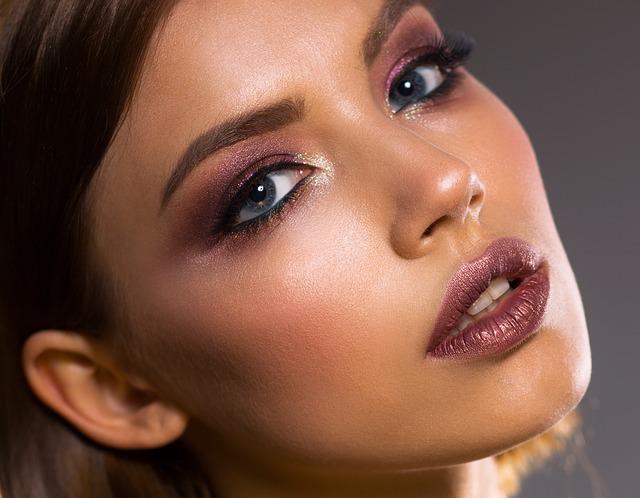
Materials and Methods
1) Sensory Panel
The sensory panel is a tool that allows evaluating hair strands treated with different products and/or combinations through the methodology of quantitative descriptive sensory analysis.
Unstructured linear scales of 10 cm are used and the product is graded from 1 to 10 and associated with concepts such as “NONE” at one end and “EXTREMELY” at the other.
Evaluators mark with a dash the position referring to the concept for each evaluated attribute. The results were submitted to Student’s t-testing. References were offered to evaluators at each session.
Example of 10 cm unstructured linear scale:
Softness
Forty strands of Caucasian hair (bleached - 5g/25 cm) were previously cleaned with a 10% SLES (Sodium Lauryl Ether Sulfate) solution. The strands were divided into 3 groups: treated with shampoo and conditioner containing 2% Hydroviton® Hair, treated with placebo shampoo and conditioner (hair formulations without the actives) and treated
with specific formulations that originated the scale references.
The strands of each group were moistened and the formulations were applied as described below:
a)
Shampoo: 0.5 g per strand; the strands were massaged for 1 minute, rinsed in running water at 33°C and allowed to dry overnight under controlled conditions of humidity and temperature (22 ± 2 °C; 50 ± 5% RH).
b)
Conditioner: 0.5 g per strand, following the same steps of shampoo application.
c) Application process of shampoo and conditioner was repeated 5 times in each strand. Each trained evaluator received a treated strand that was not exposed to the other evaluators in order to avoid influenced perceptions. Evaluated attributes were: softness, volume and frizz control and alignment.
Softness: analyzed by comparison with the references. The evaluators massaged and ran their fingers along the entire length of the strands, in order to perceive any differences in softness.
Volume Control: analyzed by comparison with references through photo records. The evaluators were trained to compare the body of the strands.
Frizz Control: analyzed by comparison with references through photo records. The evaluators were trained to score frizz as the misaligned fibers compared to the others in the body of a strand.
Alignment: analyzed by comparison with the references through photo records. The evaluators were trained to score alignment by how convergent and center-oriented the fibers are, therefore aligned in the same direction and angle.
2) Combability Evaluation
The combability test measures the force required by a standard comb to slide through a hair strand. As combing forces are dependent on the interaction between the hair cuticles and the comb, measurements may vary according to the hair’s moisture level.
2.1) Hydroviton® Hair: Improved Combability
Improved combability was evaluated according to the peak force parameter, which represents the maximum force required to comb a hair strand. Five strands of Asian hair per group (5 g, 25 cm, bleached once) were previously cleaned with a 10% SLES solution.
Test products were applied five times to each strand (0.5 mL of product + massage
for 1 minute, followed by 1 minute of rinsing in running water (33 ± 3 °C, 4 L/min).
Wet test was performed using the Dia-Stron MTT 750 testing equipment. Strands were cleaned again with a 10% SLES solution and test products were reapplied in sequence
as previously described. Strands were left to dry overnight under controlled conditions of humidity and temperature 22 ± 2 °C; 50 ± 5% RH).
Dry test was performed using the same Dia-Stron equipment. The energy involved in the combing of strands was extracted from the measurements performed. Comparisons
between treatments were performed with Student’s t test with a 95% confidence interval.
Results and Discussion
Sensory Panel
Figure 1 below shows that strands treated with Hydroviton Hair 2% showed an improvement of 8.9% in softness. The film formed on the surface of the fibers contributed to the reduction of irregularities, bringing greater alignment between the cuticles, which made them smoother, even in rinse-off formulations.
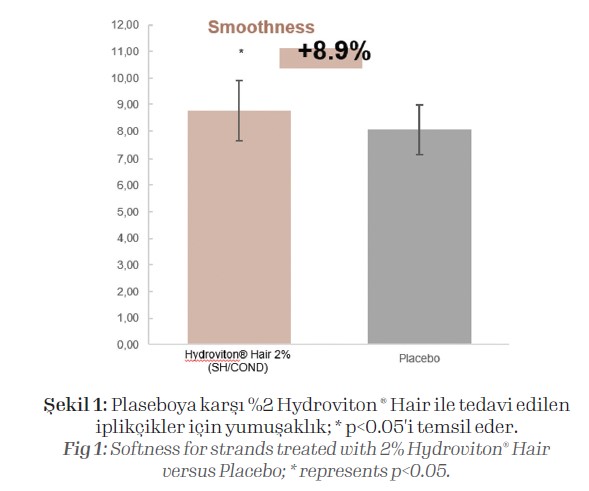
Figures 2 and 3 below show that the treatment with Hydroviton® Hair resulted in better control of frizz (by 85.3%) and volume (by 60.8%) versus placebo.
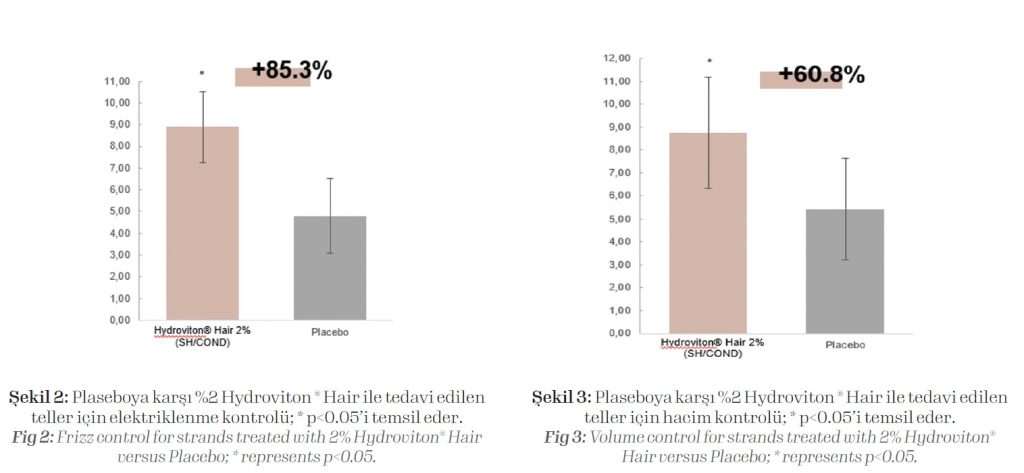
Treatment with Hydroviton® Hair 2% was also 41.9% more effective than placebo in terms of fiber alignment, as shown in Figure 4 below.
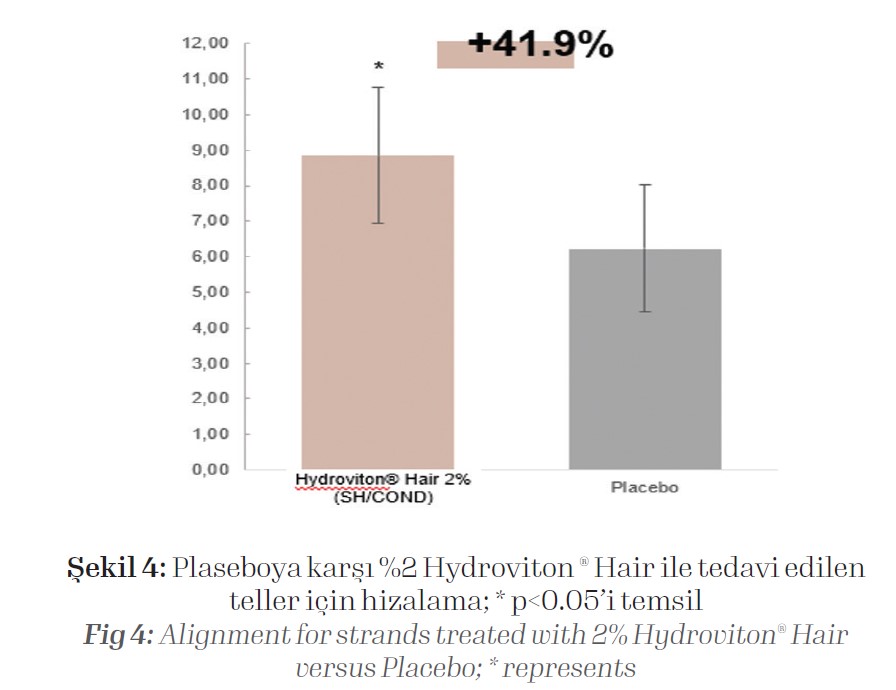
Instrumental Combability Test
As illustrated in Figures 5A and 5B below, Hydroviton ® Hair improved the combability of strands by 14% when wet and by 18% when dry.
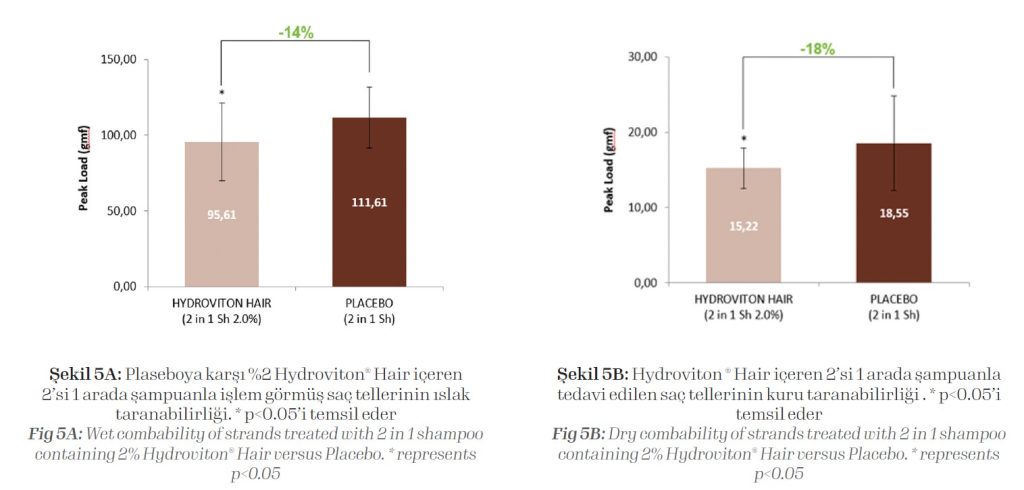
The results evidenced that the action of Hydroviton® Hair lies in its anchoring on the hair surface, forming a coating film on hair and making cuticles more aligned. The force required to comb the hair is dependent on the interaction between the cuticles and the
comb, that is, the easier the slide of the comb between the hair fibers, the lower the energy required to comb them.
In addition, by smoothing the surface, the perception of softness is increased, as well as the overall health appearance of hair, with controlled volume and frizz and greater alignment.
Conclusion
The composition of Hydroviton Hair showed good film-forming activity, supported by the presence of positively-charged arginine. At last, the product proved to be very efficient in improving wet and dry combing, in increasing the perception of softness, in taming volume and frizz and in increasing the alignment of the fibers even in rinse-off hair formulations.
The combination of these attributes demonstrates Hydroviton Hair’s ability to meet consumers’ expectations on the hydration of their hair, far beyond the water content of the fibers.
References:
(1) Ingefy Atlas, Mart 2021 – Mart 2022 vs. (2) Saç Bakımı Talepleri – Nemlendirme ve Beslenme, Symrise CICS Veritabanı, 2019. (3) FEATHERSTONE , S., Konserveleme ve İlgili İşlemlerde
Eksiksiz Bir Kurs, Cilt. 2, Bölüm 8. 14. baskı . Woodhead Yayıncılık; 2015. (4) NABORS , LO, Alternatif Tatlandırıcılar , Bölüm 18. 3. baskı. New York: Bay Decker; 2001. (5) OLIVAS ,
GI, BARBOSA-CÁNOVAS , GV Aljinat-Kalsiyum filmler: Plastikleştirici ve bağıl nem ile affetec olarak su buharı geçirgenliği ve mekanik özellikler . LWT – Gıda Bilimi ve Teknolojisi. 2007.
(6) SOTHORNVIT R., KROCHTA , JM β-laktoglobulin filmlerin mekanik özellikleri üzerinde Plastikleştirici etkisi. Gıda Mühendisliği Dergisi 2001; 50: 149-155. (7) LIMA AMF, ANDREANI
L., BORSALI R., SOLDI V. Morfoloji, ses emilimi ve filmlerin mekanik özelliklerini yumuşatma ve retiküla etme sürecini etkiler. Quimica NOVA. 2007; 30: 832-837. (8) BALLESTEROSMÁRTINEZ
L., PÉREX-CERVERA C., ANDRADE-PIZARRO R. Gliserol ve sorbitol konsantrasyonlarının tatlı patates nişastası filminin mekanik, optik ve bariyer özellikleri üzerindeki
etkisi. NFS Dergisi 20, 1-9 (2020). (9) PARRIS N., COFFIN D., JOUBRAN RF, PESSEN H. Hidrofilik Filmlerin Su Buharı Geçirgenliğini ve Çekme Özelliklerini Etkileyen Bileşim Faktörleri.
J. Agric. Food Chem., 43, 1432-1435 (1995). (10) GARRIDO C., AGUAYO T., CLAVIJO E., GOMÉZ-JERIA JS, CAMPOS-VALLETE MM pH’ın L-Arginin’in koloidal gümüş nanopartiküller
ile etkileşimi üzerindeki etkisi. Bir Raman ve SERS çalışması. J. Raman Spectrosc ., 44, 1105-1110 (2013). (11) ROBBINS , CR, İnsan Saçının Kimyasal ve Fiziksel Davranışı, Bölüm 1. 4.
baskı. New York: Springer; 2013. (12) ROBBINS , CR, İnsan Saçının Kimyasal ve Fiziksel Davranışı, Bölüm 2. 4. baskı. New York: Springer; 2013. (13) ROBBINS , CR, REICH , C., PATEL , A.,
Keratin yüzeylere adsorpsiyon: Yükle yürütülen ve hidrofobik olarak yürütülen bir süreç arasındaki süreklilik. J. Soc. kozmetik . Chem., 45, 85-94 (1994). (14) SCOTT , GV, ROBBINS, CR,
BARNHURST , JD, Kuaterner amonyum sürfaktanların insan saçıyla sorpsiyonu, J. Soc. kozmetik . Chem., 20, 135-152 (1969). (15) Mintel, GNPD – Kategori Eşleşmeleri: saç ürünleri.
Authors:
Rita Cartaxo, Bruna Nakatu, Karolina Lourenço, Rebeca Gasparin, Marcia Paula
Symrise AG
Translation and Compilation:
Özgür Çelen
Turkey Account Manager
Symrise AG


 Figures 2 and 3 below show that the treatment with Hydroviton® Hair resulted in better control of frizz (by 85.3%) and volume (by 60.8%) versus placebo.
Figures 2 and 3 below show that the treatment with Hydroviton® Hair resulted in better control of frizz (by 85.3%) and volume (by 60.8%) versus placebo.
 Treatment with Hydroviton® Hair 2% was also 41.9% more effective than placebo in terms of fiber alignment, as shown in Figure 4 below.
Treatment with Hydroviton® Hair 2% was also 41.9% more effective than placebo in terms of fiber alignment, as shown in Figure 4 below.

 The results evidenced that the action of Hydroviton® Hair lies in its anchoring on the hair surface, forming a coating film on hair and making cuticles more aligned. The force required to comb the hair is dependent on the interaction between the cuticles and the
comb, that is, the easier the slide of the comb between the hair fibers, the lower the energy required to comb them.
In addition, by smoothing the surface, the perception of softness is increased, as well as the overall health appearance of hair, with controlled volume and frizz and greater alignment.
The results evidenced that the action of Hydroviton® Hair lies in its anchoring on the hair surface, forming a coating film on hair and making cuticles more aligned. The force required to comb the hair is dependent on the interaction between the cuticles and the
comb, that is, the easier the slide of the comb between the hair fibers, the lower the energy required to comb them.
In addition, by smoothing the surface, the perception of softness is increased, as well as the overall health appearance of hair, with controlled volume and frizz and greater alignment.